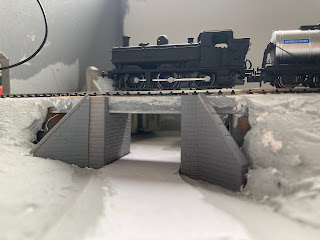Introducing Pont Dulas…
As usual, it all started with a book. “Quiet between trains” (Gowan, 2023). The title alone is so evocative, conjuring at least for me feelings of calm, bucolic country stations, the daily routine set by an infrequent parade of trains with the day passing at a steady pace of routine and paperwork, interspersed with a spot of gardening. The life of the small collection of staff at any country station, but in my mind always GWR…
Interestingly the layout has taken most direct inspiration from the Cardigan branch. The Login Station Facebook page is a further wealth of inspiration and collection of classic photographic reference material (L-R Cardigan bound freight at Penclippin, Terry Gough / 1613 Kilgerran, John McCann / Penclippin crossing, photographer unknown).
Physical mock ups progressed to the casework and another take on my cameo construction, this time the raised trackbed forming an even more rigid structure as a girder across the box. The backscene is a custom one from a photo I took actually near my Mum’s home in Pembrokeshire. Trees have been progressing slowly over several weeks and it is exciting to imagine these being used in such a wonderfully balanced scene. Composition is artful, driven by a connection to the subject with an eye on the end result and the way it can be viewed and enjoyed. Controlling this isn’t about a hierarchy between artist and viewer but rather the artist guiding the viewer and signposting the story being told.
Work can progress quickly in such a compact scheme and in evenings after work I fleshed out the landscape, keen to practice the separation of natural and man made elements, so the form of the embankment is already pleasing at this stage.
Thinking about construction is something that is less about art and more craft. What order to undertake each step can be mentally shuffled around until some logic is settled upon. In this case I determined the overbridge was important to construct and finish ahead of further scenic work. The stonework is fabricated in Slaters embossed styrene and painted in Humbrol enamels. The road was painted and textured before this was installed and bedded in with more filler. The bridge deck, girder and handrails, inspired by the bridge at Kilgerran, were scratch built in styrene and begin to lend a real sense of the finished scene here, showing the flexibility of the scene - perhaps my Cambrian stock can find a home here from time to time?
I’m deeply enjoying the process of creating this artwork, it is incredibly engaging and I feel like I’m sharpening my skills with both the craft and artistic elements of this composition. As work continues I will endeavour to focus on the artful process rather than physical craft methods but if you’ve a specific query then by all means leave a comment and I’ll happily answer specifics. Until next time, more soon…
A few weeks ago I shared a scheme developed around Pont Llanio, on the Carmarthen to Aberystwyth line, a small slice of operation (in a myriad of scales) presented in an engaging and compact form. At the end of that post I mentioned my own exploration was taking a different path - Pont Dulas is the result.
Conceived as one of a pair of matching cameo boxes, one N, one 009 (more on that another time) with shared fiddle sticks. I quickly settled on just the simplest of track plan, a gentle curve through a ‘typical’ scene. Inspired by the Aberaeron branch yes, but with a smattering of the Carmarthen line and other Cambrian and GWR branches across mid Wales. I realised I wanted to ‘paint a picture’ in 3D, a chance to play with composition, to craft some greenery and show a railway IN a landscape, typified by Penclippin on the Cardigan branch (left, below). I explored the story tracing pen over paper, moving to card building mock ups, enjoying the process of taking inspiration and crafting a believable scene through interpretation. I was fuelled by the feelings in that opening paragraph as well as my own time spent in and around the area. Of course there is also my life long love of the GWR branchline - a seed planted young and nurtured by Dad and Grandpa through childhood, fuelled by models, books, stories and preserved railways - all this now poured out into a 60 x 22cm scene.
I take frequent photos. I spend time absorbing the incomplete scene.
This helps evolve the composition further.
This helps evolve the composition further.
Finally, a short note on the name… regulars will remember my OO industrial slice of North Wales called Pont-y-dulais. When scouring an OS map of the area north of Lampeter I found the small ‘Afon Dulas’. The rest is a childish delight in the similarity.
Donate
I love writing and creating material for the blog. If you enjoy what you read and engage with I would be appreciative of any donation, large or small, to help me keep it advert and restriction free.












Comments
Post a Comment
Thank you for leaving a comment on my blog - I appreciate you taking the time to share your views. If you struggle to log in, please turn off the ‘block cross-site tracking’ setting in your browser.
James.